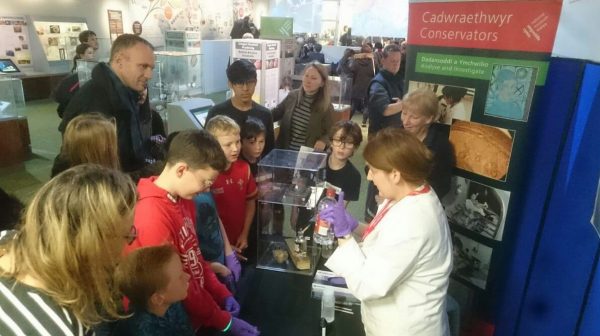Public Speaking for the Terrified Conservator: Children and Teenagers Edition
6 March 2018
Public speaking: the one aspect of life that we are doomed to never get away from. Whether it’s raising your hand in class, or standing in front of a presentation, it is the one academic and professional prospect that is guaranteed to crank up stress levels like no other. Gigantic, mountainous, essay? Not a problem. Five minute presentation in front of the faculty regarding your latest treatment plan? Oh sorry, I couldn’t hear that from this panic hole that I immediately just dug.
There is just something about public speaking that seems to set everyone’s teeth on edge. But it is a skill like any other, and it is one that is remarkably useful to have. If you can diversify the ways you can communicate to different groups of people, you can be fully prepared to adapt to anything the field can throw at you. And one of the most challenging groups to effectively communicate to are kids.

Now as a professional conservator, the chances of you having to speak about your field in front of children is slim. But it does exist as a possibility. And in this age of diversifying the resume, possessing more marketable skills is better. If you put on your resume that you can talk to kids about conservation, it’s one more thing that will make you stand out.

Prior to 2015 I did not have this skill. Giving a presentation in class was like accidentally eating a hot pepper: sweaty, uncomfortable, and numbness becomes the best option for your tongue. But in the summer of 2015, many years after my last in-class presentation, I got a new job: tour guide at the Alberta Legislature building. From Sunday to Sunday depending on my shift I could be counted on to either give free hour long walk-in tours; guide a group around the latest exhibit in the art gallery space and movie theatre; or else merely shepherd a class of 12-year old’s around the entire facility for the whole day for a special booked tour.

The whole day. This includes tours, games, activities, and a mock legislature procedure where I had to guide them through the process of passing a bill in house and explain why the government did the things they did. While getting them into costumes and using sets and props. I was essentially talking to this group of kids all day long about things that they (sometimes) did not care about in the least.

And it was fantastic. The more I did it, the more I enjoyed it. I really came to appreciate that spark of “oh, now I get it” that I would get at times. But as much as I came to like it, it was a long journey wherein I had to keep practicing a skill that I was bad at. For instance, one of my first official tours I became so nervous at talking for so long that I got confused by staircases and accidentally led my group into the basement of the building. I had to pretend that it was the normal conclusion to the tour and usher them out the back.

Messing up happens. And it’s not the end of the world if you do it. The sun still rises, and you just try again the next day with a different group. It was like exercising a muscle that I never knew I had. So learn from my experiences and mistakes! Your best two tools for public speaking are going to be practice and research. Practice what you’re going to say over and over until it becomes muscle memory. And research like you’re going to a dream job interview.

If you’re talking in front of a group of kids, it’s usually a good idea to speak to them about different things depending on what they are learning about in school. If you phrase your communication to intersect with their own life experiences your message will have a greater chance of landing. Below I have compiled a chart of different age groups and curriculum focuses. I’ve based this off the curriculum in Canada, but you can do your own research into the educational standards of your choice.


Photos are not reflective of Alberta Legislature Building but instead of students on historic sites and field trips.
- March 2024 (1)
- December 2023 (1)
- November 2023 (2)
- March 2023 (2)
- January 2023 (6)
- November 2022 (1)
- October 2022 (1)
- June 2022 (6)
- January 2022 (8)
- March 2021 (2)
- January 2021 (3)
- June 2020 (1)
- May 2020 (1)
- April 2020 (1)
- March 2020 (4)
- February 2020 (3)
- January 2020 (5)
- November 2019 (1)
- October 2019 (1)
- June 2019 (1)
- April 2019 (2)
- March 2019 (1)
- January 2019 (1)
- August 2018 (2)
- July 2018 (5)
- June 2018 (2)
- May 2018 (3)
- March 2018 (1)
- February 2018 (3)
- January 2018 (1)
- December 2017 (1)
- October 2017 (4)
- September 2017 (1)
- August 2017 (2)
- July 2017 (1)
- June 2017 (3)
- May 2017 (1)
- March 2017 (2)
- February 2017 (1)
- January 2017 (5)
- December 2016 (2)
- November 2016 (2)
- June 2016 (1)
- March 2016 (1)
- December 2015 (1)
- July 2014 (1)
- February 2014 (1)
- January 2014 (4)